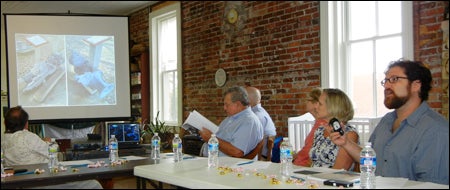ECU researchers explore history near Columbia

Dr. Nathan Richards, far right, presents information about known shipwrecks on the Scuppernong River at the Pocosin Arts Center in June. (Contributed photo)
East Carolina University researchers are collaborating this fall with the UNC Coastal Studies Institute and the citizens of Columbia, N.C. to explore the region’s history and close connection with the state’s coastal waterways.
Initial findings will be presented at an Oct. 6 public forum to be held in conjunction with the community’s annual Scuppernong River Festival and at an information booth open at the festival Oct. 8. More detailed results will be shared in a public symposium planned for late 2011 and a publication in the works for 2012. A grant application related to the project is also under development.

An old photograph of the mail boat, the "Estelle Randall," is among the artifacts uncovered so far in the collaborative project. (date unknown; Source: Mariners Museum PB2876 C176).
The researchers will use side-scanning sonar to search for lost shipwrecks in Bulls Bay and the Scuppernong River, while local residents provide a backdrop through their stories of the region’s history. Topics for study include waterway modifications, the evolution of trade networks and the fishing, lumber and naval store industries in the area.
ECU history professor Dr. Nathan Richards, who specializes in nautical archaeology, met with residents in June to begin conversations about the project. Collection of oral histories has begun, including stories of how residents relied on boats from Elizabeth City to bring the mail and goods that were traded for vegetables, fish and crabs. Residents will provide river tours and house students and faculty participating in the research.
The grant application will seek funding for the development of a digital media project, The Scuppernong River Heritage Trail, which could be presented in tandem with the existing Scuppernong River Interpretative Boardwalk, a .75-mile wetlands trail near Columbia.
Richards said the area provides the perfect location for a maritime heritage trail because of the existing infrastructure, the extensive history in the area and the two prominent rivers in the area (the Scuppernong and Alligator Rivers). Columbia is also situated along a major tourism corridor, he said, as a stop along the route to the North Carolina Outer Banks.
For additional information, contact Richards at 252-258-4264 or richardsn@ecu.edu.
###